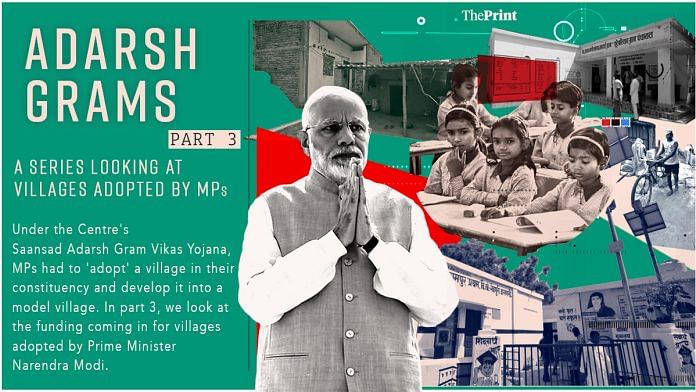Varanasi: Just until two years ago, the dusty lanes of Varanasi’s Pure Bariyar village rarely saw any outsiders. Then, Prime Minister Narendra Modi adopted it under the government’s ambitious Adarsh Gram scheme, designed for MPs to transform select villages in their constituencies into models of development. Today, Pure Bariyar is a pristine poster child for rural progress, even hosting a multinational delegation last year to learn from its gram panchayat. But this transformation isn’t just the result of governmental efforts.
Much of the development in Pure Bariyar and six other Modi-branded villages has been funded by big names like Reliance Foundation, Hindustan Petroleum Corporation Limited (HPCL), and even Patanjali Yog Sansthan, mainly through their Corporate Social Responsibility quotas. For instance, Pure Bariyar, which was adopted in 2021-22, received Rs 4.05 crore from HPCL for interlocking roads, a baraat ghar, a panchayat bhavan boundary wall, a health centre, and solar street lights, according to district administration documents in possession of ThePrint.
Pure Bariyar comes under the Saansad Adarsh Gram Yojana (SAGY), which was launched with great fanfare in 2014 and promised to transform rural India one MP and one village at a time. The idea was that each MP would adopt a village and turn it into a model by 2016, continuing to add five more villages by 2024. However, the scheme has faced challenges from the outset. Participation has fallen short of expectations and in many states and Union territories, the completion rate for projects in adopted villages is 75 percent or less.
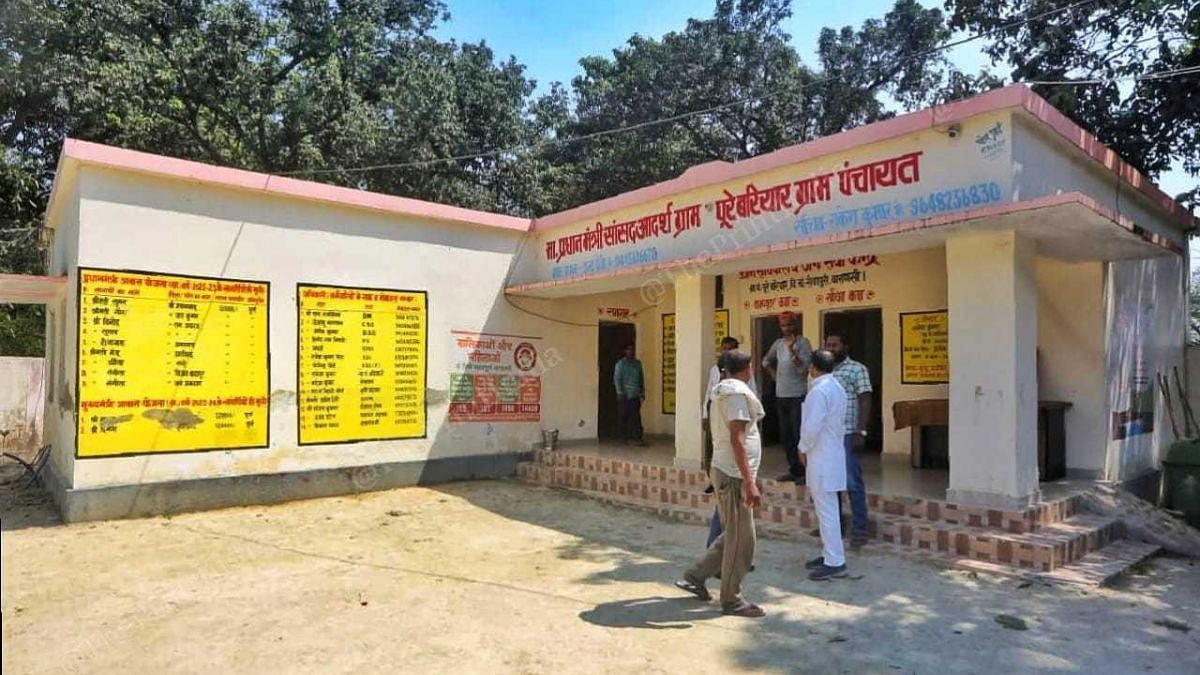
A frequently cited reason for these issues is the lack of dedicated funding. The SAGY guidelines stipulate that creating an adarsh village requires cobbling together funds from various government schemes and “mobilising additional resources”.
As an official statement released last year by the Ministry of Rural Development explained, the creation of model villages is envisaged through a combination of existing government programmes and mobilising “community and private resources”. It also clarified that the scheme has no funds allocated specifically for it and that the money raised is not maintained centrally.
However, even as other MPs have complained about a lack of funds, Modi’s seven adopted villages have hit the jackpot when it comes to “mobilising resources”, whether from government companies or private players.
All seven villages adopted by Modi — Jayapur, Nagepur, Kakrahiya, Parampur, Pure Bariyar, Pure Gaon, and Kuruhua — have received big infusions of corporate funds, or are in the process of receiving them, even if occasional snags in scheme implementation, maintenance, and administration have occurred along the way. When ThePrint visited Jayapur, Kakrahiya, Pure Bariyar, and Pure Gaon earlier this month, many amenities were bankrolled by CSR efforts, with corporate logos occasionally popping up next to Modi’s name on plaques and signboards.
And more seems to be on the way. Government sources told ThePrint that Oil and Natural Gas Corporation (ONGC) will contribute Rs 25 crore for the seven villages and the first installment has already been paid.
Also Read: Modi promised India model villages. It is now a blot for us, say Adarsh gram voters
Keeping good company
Inside the well-maintained primary school compound in Kakrahiya sits the bright blue and yellow ‘Nand Ghar’, a modern anganwadi. Here, children play with toys, swing on the swings, maybe even pick up a thing or two from the numerous posters on English alphabets, shapes, and human anatomy. But what stands out from the murals of trees, giraffes, and monkeys is the name and logo of mining giant Vedanta, the company that funded the anganwadi’s construction.
This juxtaposition of corporate symbols with rural scenery is not uncommon in the four Modi villages that ThePrint visited, all of which live up to the adarsh tag, at least at first sight.
For instance, Jayapur, the first village adopted by Modi boasts a vibrantly painted panchayat bhawan, a public library with a computer, an open gym, a spotless public washroom, numerous solar street lights, and a NADEP pit with a solar array, and a huge playground equipped with a badminton net.

Many of the facilities in this village are courtesy CSR funds, overseen largely by CR Patil, president of the Gujarat BJP and Navsari MP. Patil’s website claims that Modi “handed over (to him) the responsibility of his adopted village of Jayapur”. In fact, Patil himself has given at least Rs 1.84 crore to Jayapur for various development projects, including 400 personal toilets. In collaboration with Haridwar-based Patanjali Yog Sansthan, he also helped raise Rs 26 lakh for a water pipeline here.
Additionally, the village has two solar power plants installed by Welspun Energy Private Limited for Rs 3 crore, ensuring that even during power outages, residents can keep at least one light on in their homes. (In 2016, Tata Power acquired Welspun Energy’s Renewable Energy portfolio).
Similarly, Parampur, adopted in 2020-21, has received Rs 7.02 crore from the National Mineral Development Corporation (NMDC) for various projects, including a playground and its boundary wall, training for weavers, power looms, solar street lights, and an open gym, among other things.
The latest additions to Modi’s stable of villages have also attracted an influx of CSR funding.
Poore Gaon, adopted in 2022-23, has received funding from Reliance Foundation, and Kuruhua, which joined the list in 2023-24, has received funding from Vedanta — in both cases for constructing anganwadi kendras. Vedanta and Reliance Foundation have established similar anganwadi kendras in the country as well. Poore Gaon has received Rs 37 lakh and Kuruhua Rs 22.50 lakh for the anganwadis.
Also Read: ‘Izzat ghars’ to ATMs, Modi’s adopted villages have leaped into 21st-century India, with some bumps
Money keeps flowing but challenges remain
The Modi villages that ThePrint visited had better physical infrastructure than their neighbours, including more extensive road coverage, a wider distribution of government-built individual toilets, and improved cleanliness.
Pure Bariyar, for one, has seen a sea change since its adoption by PM Modi, according to Arvind Singh Patel, de facto pradhan of the village.
“Before PM Modi adopted the villages, we used to get a very low budget. So, all the development work couldn’t be done. But since he adopted this village, the gram sabha has received so much CSR funding that we have hardly any development work left,” he said. “The Prime Minister has sanctioned a Rs 1-1.5 crore CSR budget for whatever few development projects are left. After the elections, no development work will be left in this village.”
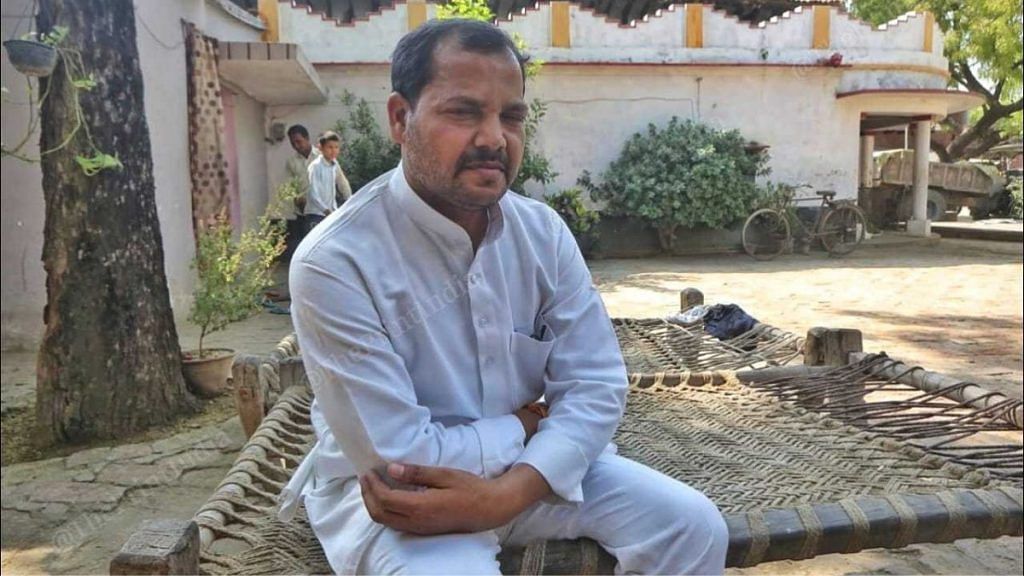
Now, all seven villages are slated to get more money thanks to ONGC, said government officials, with a total corpus of Rs 25 crore.
Out of this, ONGC will be putting in Rs 1.39 crore in Kakrahiya, for the construction of internal streets, CCTV cameras, solar lights, and an open gym, among other things.
Kuruhua, the youngest adopted village, will get Rs 4.31 crore for various works, including the construction of a drainable system, a park, amrit sarovar (waterbody), solar lights, and playground renovation.
Pure Bariyar is slated to get Rs 1.63 crore for an anganwadi centre, a digital library, solar lights, a soak pit for wastewater management, and an internal street, among other things.
Poore Gaon and Parampur are set to receive Rs 9.16 crore and Rs 1.96 crore respectively for similar upgrades, while two of Modi’s oldest adopted villages — Jayapur and Nagepur — will get Rs 2.96 crore and Rs 3.95 crore.
ThePrint was informed that the work has been temporarily suspended due to the imposition of the Model Code of Conduct. However, the first installment of funds from ONGC has already been received.
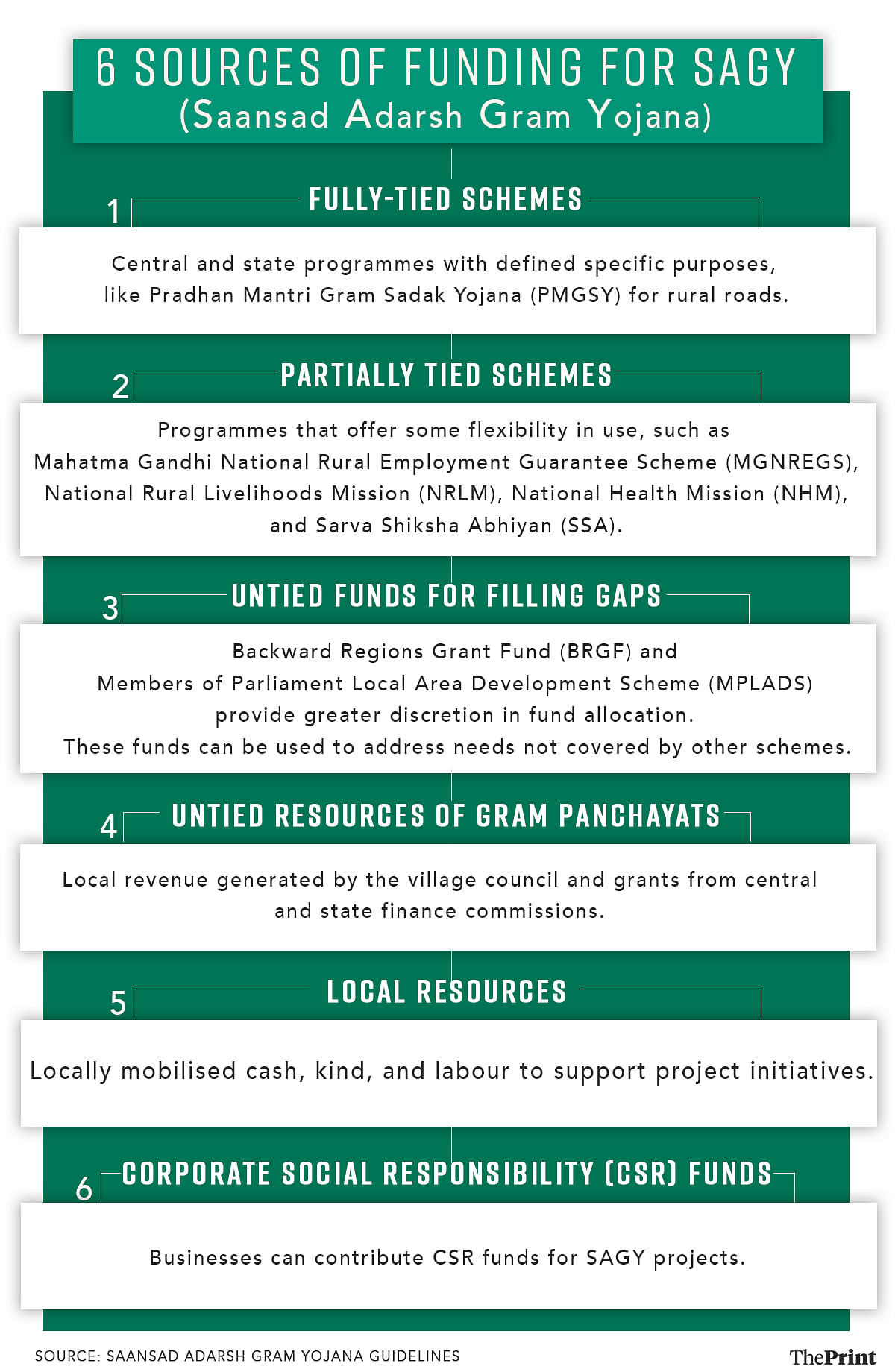
Government officials in Varanasi reported that through CSR initiatives, a total of 192 additional houses have been sanctioned across these seven villages.
Yet, while there seems to be no shortage of money coming into the Modi villages, coordination between companies and officials, as well as infrastructure maintenance pose challenges. There are disparities between what’s on paper and the reality on the ground.
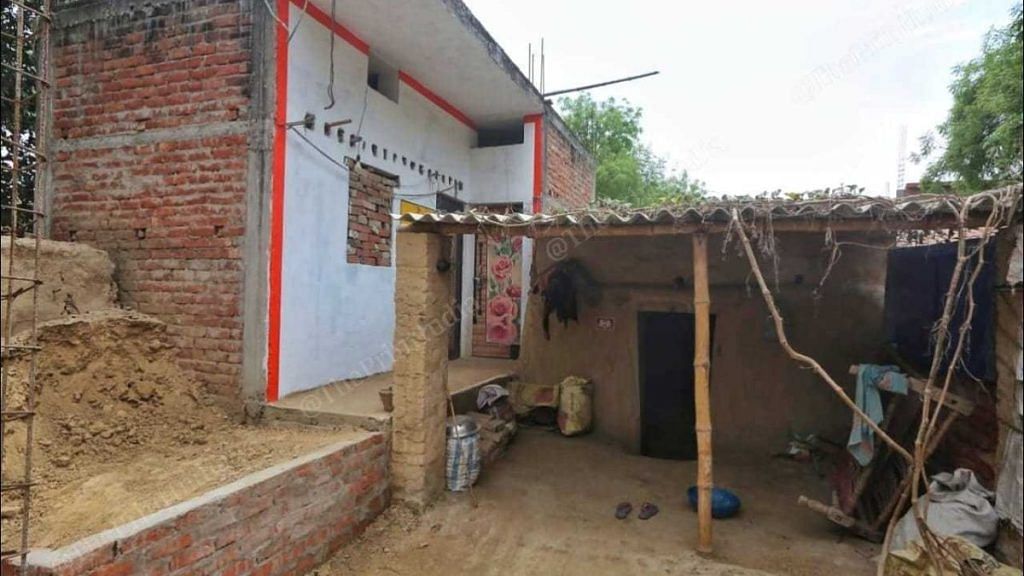
For instance, the 2023-24 progress report for Kakrahiya village claims that two drinking water projects using Jal Nigam and CSR funds are operational, providing “clean drinking water to all villagers.” However, during ThePrint’s visit, residents expressed anger about a non-functional Rs 1.45 crore water tank built under SAGY in 2019. The people complained they had to rely on borewells for water or have to request water from those who have private machines.
Even with funds flowing into these villages, administrative apathy and lack of follow-up often lead to disrepair or gaps in facilities, as evidenced by the broken tap in Kakrahiya’s public washroom or the absence of streetlights in Pure Gaon.
As early as 2016, the Indian Express reported struggles with effective coordination between village officials, government agencies, and CSR-contributing companies in Jayapur. This led to issues like a newly built tile road crumbling because it wasn’t taken into account that heavy tractors used it, and so concrete would have been a more suitable material for it.
Regardless of their current status, most projects under the Saansad Adarsh Gram Yojana proudly display signs crediting both the scheme and PM Modi. Even a single solar streetlight in Kakrahiya village bears a board with his name and the year it was installed. “The light stopped working long ago because its batteries were stolen,” Kakrahiya resident Vikas said.
(Edited by Richa Mishra and Asavari Singh)
Also Read: Modi govt is changing rural India. They are spending differently from MGNREGA era


